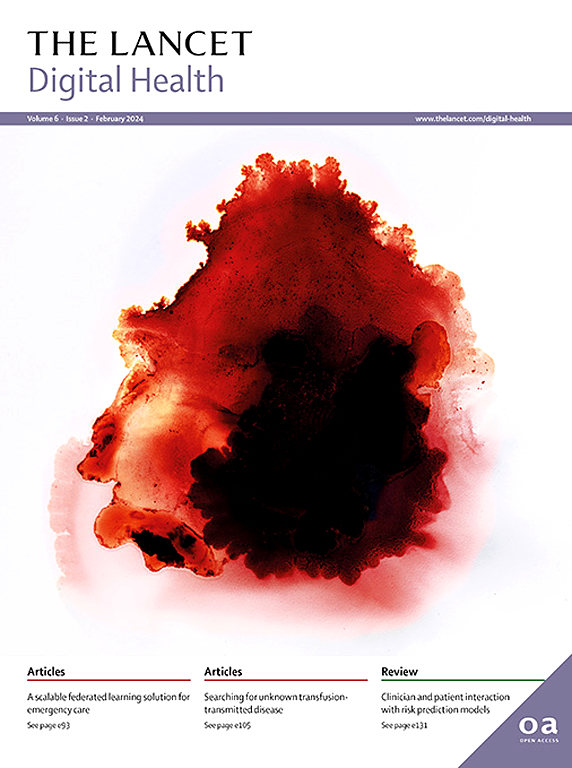Proteomic organ-specific ageing signatures and 20-year risk of age-related diseases: the Whitehall II observational cohort study
IF 23.8
1区 医学
Q1 MEDICAL INFORMATICS
引用次数: 0
Abstract
Background
Biological ageing is known to vary among different organs within an individual, but the extent to which advanced ageing of specific organs increases the risk of age-related diseases in the same and other organs remains poorly understood.
Methods
In this observational cohort study, to assess the biological age of an individual's organs relative to those of same-aged peers, ie, organ age gaps, we collected plasma samples from 6235 middle-aged (age 45–69 years) participants of the Whitehall II prospective cohort study in London, UK, in 1997–99. Age gaps of nine organs were determined from plasma proteins via SomaScan (SomaLogic; Boulder, CO, USA) using the Python package organage. Following this assessment, we tracked participants for 20 years through linkage to national health records. Study outcomes were 45 individual age-related diseases and multimorbidity.
Findings
Over 123 712 person-years of observation (mean follow-up 19·8 years [SD 3·6]), after excluding baseline disease cases and adjusting for age, sex, ethnicity, and age gaps in organs other than the one under investigation, individuals with large organ age gaps showed an increased risk of 30 diseases. Six diseases were exclusively associated with accelerated ageing of their respective organ: liver failure (hazard ratio [HR] per SD increment in the organ age gap 2·13 [95% CI 1·41–3·22]), dilated cardiomyopathy (HR 1·65 [1·28–2·12]), chronic heart failure (HR 1·52 [1·40–1·65]), lung cancer (HR 1·29 [1·04–1·59]), agranulocytosis (HR 1·27 [1·07–1·51]), and lymphatic node metastasis (HR 1·23 [1·06–1·43]). 24 diseases were associated with more than one organ age gap or with organ age gaps not directly related to the disease location. Larger age gaps were also associated with elevated HRs of developing two or more diseases affecting different organs within the same individual (ie, multiorgan multimorbidity): 2·03 (1·51–2·74) for the arterial age gap, 1·78 (1·48–2·14) for the kidney age gap, 1·52 (1·38–1·68) for the heart age gap, 1·52 (1·12–2·06) for the brain age gap, 1·43 (1·16–1·78) for the pancreas age gap, 1·37 (1·17–1·61) for the lung age gap, 1·36 (1·26–1·46) for the immune system age gap, and 1·30 (1·18–1·42) for the liver age gap.
Interpretation
Advanced proteomic organ ageing is associated with the long-term risk of age-related diseases. In most cases, faster ageing of a specific organ increases susceptibility to morbidity affecting multiple organs.
Funding
Wellcome Trust, UK Medical Research Council, National Institute for Aging, Academy of Finland.
蛋白质组学器官特异性衰老特征和年龄相关疾病的20年风险:Whitehall II观察队列研究
生物衰老在个体的不同器官之间是不同的,但是特定器官的衰老在多大程度上增加了相同器官和其他器官中与年龄相关的疾病的风险,人们仍然知之甚少。方法在这项观察性队列研究中,为了评估个体器官相对于同龄人的生物年龄,即器官年龄差距,我们收集了1997-99年英国伦敦Whitehall II前瞻性队列研究中6235名中年(45-69岁)参与者的血浆样本。利用SomaScan (SomaLogic;Boulder, CO, USA),使用Python包管理。在此评估之后,我们通过与国家健康记录的联系对参与者进行了20年的跟踪。研究结果为45例个体年龄相关疾病和多病。在123 712人年的观察(平均随访19.8年[SD 3.6])中,在排除基线疾病病例并对年龄、性别、种族和非调查器官年龄差距进行调整后,器官年龄差距较大的个体显示30种疾病的风险增加。有6种疾病与各自器官的加速衰老完全相关:肝功能衰竭(器官年龄差距中每SD增量的危险比[HR]为2.13 [95% CI为1.41 - 1.22])、扩张型心肌病(HR 1.65[1.28 - 1.12])、慢性心力衰竭(HR 1.52[1.40 - 1.65])、肺癌(HR 1.29[1.04 - 1.59])、粒细胞缺血症(HR 1.27[1.07 - 1.51])和淋巴结转移(HR 1.23[1.06 - 1.43])。24种疾病与不止一种器官年龄差距相关,或者与疾病部位没有直接关系的器官年龄差距相关。较大的年龄差距还与同一个体内发生影响不同器官的两种或两种以上疾病(即多器官多病)的hr升高有关:动脉年龄差距为2.03(1.51 - 1·74),肾年龄差距为1.78(1.48 - 2·14),心脏年龄差距为1.52(1.38 - 1·68),脑年龄差距为1.52(1.12 - 2·06),胰腺年龄差距为1.43(1.16 - 1·78),肺年龄差距为1.37(1.17 - 1·61),免疫系统年龄差距为1.36(1.26 - 1·46),肝脏年龄差距为1.30(1.18 - 1·42)。晚期蛋白质组器官衰老与年龄相关疾病的长期风险相关。在大多数情况下,特定器官的快速衰老会增加对影响多个器官的发病率的易感性。资助:威康信托基金、英国医学研究理事会、国家老龄研究所、芬兰科学院。
本文章由计算机程序翻译,如有差异,请以英文原文为准。
求助全文
约1分钟内获得全文
求助全文
来源期刊

Lancet Digital Health
Multiple-
CiteScore
41.20
自引率
1.60%
发文量
232
审稿时长
13 weeks
期刊介绍:
The Lancet Digital Health publishes important, innovative, and practice-changing research on any topic connected with digital technology in clinical medicine, public health, and global health.
The journal’s open access content crosses subject boundaries, building bridges between health professionals and researchers.By bringing together the most important advances in this multidisciplinary field,The Lancet Digital Health is the most prominent publishing venue in digital health.
We publish a range of content types including Articles,Review, Comment, and Correspondence, contributing to promoting digital technologies in health practice worldwide.
 求助内容:
求助内容: 应助结果提醒方式:
应助结果提醒方式:


